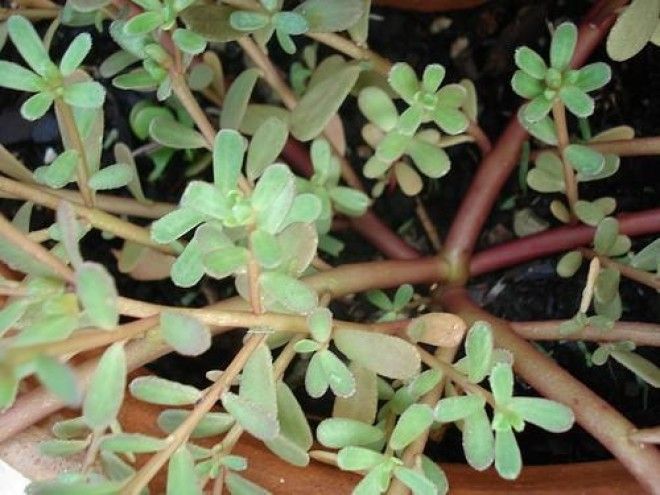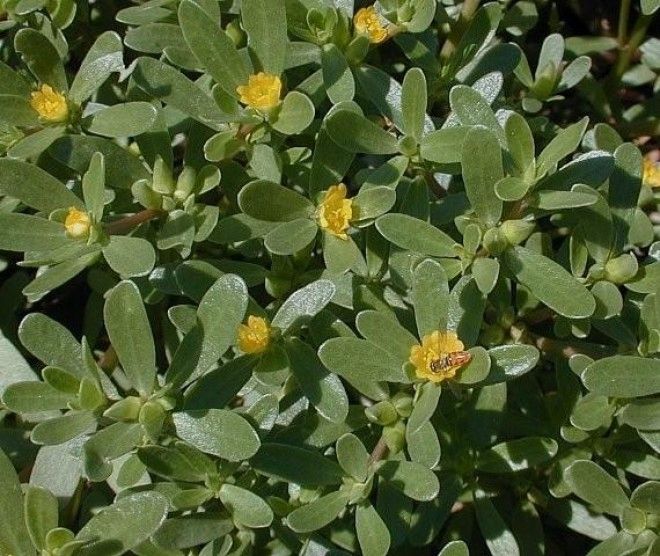It started its cultivation in India and Persia, and spread to the rest of the world. Some cultures pluck it out and throw it away with leaf clippings and other weeds, while others cultivate it specifically to eat as food.
Purslane is an aesthetically attractive weed with fleshy leaves and often yellow flowers, but its health benefits are even more desirable.
Power-Packed Purslane

Common in our yards but little known in the North American kitchen, purslane is both delicious and exceptionally nutritious. Common purslane (Portulaca oleracea) — also known as duckweed, fatweed, pursley, pussley, verdolagas and wild portulaca — is the most frequently reported “weed” species in the world. It can grow anywhere that has at least a two-month growing season.
Until recently, most research on purslane has focused on its eradication. A frequently overlooked approach to controlling this weed is to eat it! Purslane is so surprisingly tasty, North Carolina market gardener Patryk Battle says, “I have rarely had anybody not buy purslane after they’ve tried it.”
Purslane is somewhat crunchy and has a slight lemony taste. Some people liken it to watercress or spinach, and it can substitute for spinach in many recipes. Young, raw leaves and stems are tender and are good in salads and sandwiches. They can also be lightly steamed or stir-fried. Purslane’s high level of pectin (known to lower cholesterol) thickens soups and stews.
Battle also uses purslane in pesto. He throws basil and purslane (upper stems and all) into a blender or food processor, adds a small amount of olive oil, garlic, pine nuts and enough hot water to get a good consistency. Because it’s so juicy, purslane helps create a low-fat pesto without too much oil.
Powerful Seeds Grow in Many Climates

The seeds of purslane are so powerful they can stay viable in land for up to 40 years – and this is a natural crop – no GMO! It grows in a well-tended garden and in arid climates, often equally as well. This resilient plant poses similar benefits for our immune systems and overall health.
Often called pig weed (and it certainly would be better for your pigs than some of the GMO grain many farmers have been using to feed their livestock), Purslane has more beneficial Omega 3 fatty acids than many fish oils! The weed also has one of the highest levels of vitamin A among all leafy green vegetables (1320 IU/100 g, provides 44% of RDA). High Vitamin A foods can help protect us from many types of cancers and helps to boost eye health.
When you learn how to cook with the right ingredients, you can really begin to enjoy both the fat-burning properties and the ultimate flavor of the foods you use to slim your waist.
And that's exactly what Dave and Karine have put together in the Metabolic Cooking series -- more than 250 mouth-watering, fat-annihilating recipes for you to choose from. And of course, they also have many fat burning salad dressing recipe!
Strong Anti-Oxidant

Furthermore, purslane is full of two different types of betalain alkaloid pigments – a reddish beta-cyanis and a yellow beta-xanthins, which are equally potent antioxidants and anti-mutagens. Also in purslane are vitamins C, and B-complex including riboflavin, pyridoxine, and niacin, as well as carotenoids, and trace minerals like iron, magnesium, and calcium.
Advertising
With all these nutritional benefits, and the large amounts of money we spend on supplements to better our health, it seems purslane should be elevated from weed status to health-boosting, everyday food. Purslane packs a powerful nutritional punch, for certain.
More Health benefits of Purslane
This wonderful green leafy vegetable is very low in calories (just 16 kcal/100g) and fats; nonetheless, it is rich in dietary fiber, vitamins, and minerals.
Fresh leaves contain surprisingly more omega-3 fatty acids (a-linolenic acid) than any other leafy vegetable plant. 100 grams of fresh purslane leaves provide about 350 mg of alpha-linolenic acid. Research studies show that consumption of foods rich in omega-3 fatty acids may reduce the risk of coronary heart disease, stroke, and help prevent the development of ADHD, autism, and other developmental differences in children.
It is an excellent source of Vitamin A, (1320 IU/100 g, provides 44% of RDA) one of the highest among green leafy vegetables. Vitamin A is a known powerful natural antioxidant and an essential vitamin for vision. It is also required to maintain healthy mucusa and skin. Consumption of natural vegetables and fruits rich in vitamin A is known to help to protect from lung and oral cavity cancers.
Purslane is also a rich source of vitamin C, and some B-complex vitamins like riboflavin, niacin, pyridoxine and carotenoids, as well as dietary minerals, such as iron, magnesium, calcium, potassium, and manganese.
Furthermore, present in purslane are two types of betalain alkaloid pigments, the reddish beta-cyanins and the yellow beta-xanthins. Both pigment types are potent anti-oxidants and have been found to have anti-mutagenic properties in laboratory studies.

